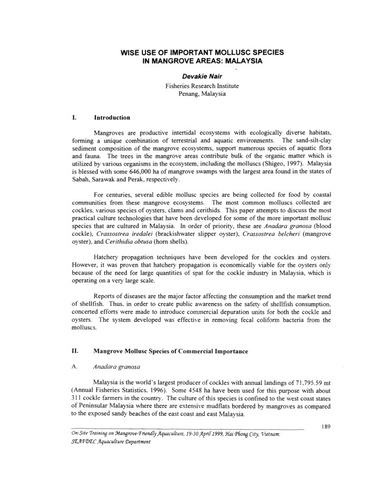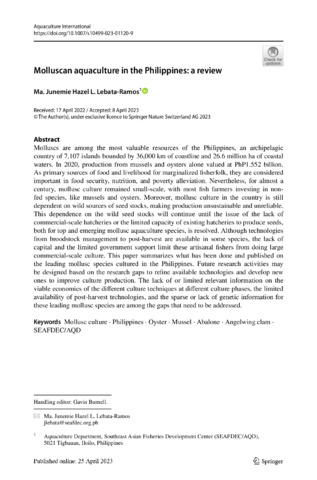Growth and survival of oyster Crassostrea iredalei (Faustino, 1932): A comparison of wild and hatchery-bred spat in grow-out culture
| dc.contributor.author | Lebata-Ramos, Ma. Junemie Hazel | |
| dc.contributor.author | Dionela, Cleresa S. | |
| dc.contributor.author | Novilla, Schedar Rose M. | |
| dc.contributor.author | Sibonga, Rema | |
| dc.contributor.author | Solis, Ellen Flor D. | |
| dc.contributor.author | Mediavilla, Jonas P. | |
| dc.date.accessioned | 2021-01-04T06:47:09Z | |
| dc.date.available | 2021-01-04T06:47:09Z | |
| dc.date.issued | 2021-03-15 | |
| dc.identifier.citation | Lebata-Ramos, Ma. J. H. L., Dionela, C. S., Novilla, S. R. M., Sibonga, R. C., Solis, E. F. D., & Mediavilla, J. P. (2021). Growth and survival of oyster Crassostrea iredalei (Faustino, 1932): A comparison of wild and hatchery-bred spat in grow-out culture. Aquaculture, 534, 736310. https://doi.org/10.1016/j.aquaculture.2020.736310 | en |
| dc.identifier.issn | 0044-8486 | |
| dc.identifier.uri | http://hdl.handle.net/10862/6019 | |
| dc.description.abstract | Oyster farming is an important industry both in developed and developing countries. The high demand for oysters has caused overexploitation of natural stocks. This led to dwindling spat fall and unstable production. This study was conducted to compare growth and survival of wild and hatchery-bred spat of the oyster Crassostrea iredalei in grow-out culture. Results of the experiment revealed that both wild (n = 1450) and hatchery-bred spat (n = 1450) had comparable growth rates in grow-out culture. Growth rates of wild and hatchery-bred oysters did not differ significantly at 5.69 ± 0.88 mm shell length (SL) and 8.85 ± 1.07 g body weight (BW) mo−1 and 6.88 ± 1.33 mm SL and 8.26 ± 1.15 g BW mo−1, respectively. Growth rates, in terms of shell length, both for wild (p < 0.05, r = 0.74) and hatchery-bred oysters (p < 0.05, r = 0.76), showed strong positive correlation with salinity. Meat yield was almost the same at 16.41 ± 0.57% for wild oysters and 15.59 ± 0.37% for the hatchery-bred ones. Proximate composition of dried whole flesh oyster samples also showed the same amounts of crude protein, crude fat, crude fiber, nitrogen free extract, and ash in both wild and hatchery-bred oysters. The length-weight relationships of wild [W = 0.000492 L2.6512 (R2 = 86.8%, p < 0.001)] and hatchery-bred [W = 0.000052 L3.1779 (R2 = 92.6%, p < 0.001)] C. iredalei were also calculated from the length and weight data obtained during the duration of culture and revealed higher b for the smaller hatchery-bred oysters. Moreover, mean survival at harvest did not significantly differ at 85.03 ± 1.09% for wild oysters and 85.31 ± 1.40% for the hatchery-bred ones (Two-sample t-test, p > 0.05). The results of this study showed the potential of hatchery-bred oyster spat as seeds for grow-out culture to address the declining number of spat fall in natural oyster beds. Producing the same quality of oysters, it can be inferred that the hatchery-bred spat are just as competent as their wild conspecifics. | en |
| dc.description.sponsorship | The Project Team greatly appreciates the Philippine Council for Agriculture, Aquatic, and Natural Resources Research and Development of the Department of Science and Technology (DOST-PCAARRD) for funding this three-year project (Project Code 6286-TRD-DOST-O4); Dr. Mari-Ann M. Acedera, Ms. Ester C. Zaragoza, Ms. Adela C. Corpuz and all the staff of the Marine Resources Research Division of DOST-PCAARRD for their assistance and support from proposal submission to project termination; the Aquaculture Department of the Southeast Asian Fisheries Development Center (SEAFDEC/AQD) for personnel support (Budget Code 5106-T-RD) and for facilitating the smooth implementation of the project; Mr. Patrick Frances Alicante, Mr. Silverio Tibudan and Mr. Winnie Tibudan for their kind assistance in the field; the Oyster Hatchery Team for providing the hatchery-bred spat; the Local Government Unit and the people of New Washington, Aklan for welcoming the team and allowing the conduct of the experiment in their locality; and the four anonymous journal reviewers for painstakingly reviewing the manuscript. | en |
| dc.language.iso | en | en |
| dc.publisher | Elsevier | en |
| dc.subject | Crassostrea iredalei | en |
| dc.subject | hatcheries | en |
| dc.title | Growth and survival of oyster Crassostrea iredalei (Faustino, 1932): A comparison of wild and hatchery-bred spat in grow-out culture | en |
| dc.type | Article | en |
| dc.identifier.doi | 10.1016/j.aquaculture.2020.736310 | |
| dc.citation.volume | 534 | |
| dc.citation.spage | 736310 | |
| dc.citation.journalTitle | Aquaculture | en |
| dc.subject.asfa | oyster culture | en |
| dc.subject.asfa | growth | en |
| dc.subject.asfa | spat | en |
| dc.subject.asfa | oysters | en |
| dc.subject.asfa | length-weight relationships | en |
| dc.subject.asfa | survival | en |
| dc.subject.asfa | water temperature | en |
| dc.subject.asfa | aquaculture | en |
| dc.subject.scientificName | Crassostrea iredalei | en |
| dc.subject.scientificName | Magallana bilineata | en |
| local.subject | Crassostrea iredalei | |
| local.subject | Wild | en |
| local.subject | Hatchery-bred | en |
| local.subject | Culture | en |
| local.subject | SEAFDEC/AQD | en |
このアイテムのファイル
| ファイル | サイズ | フォーマット | 閲覧 |
|---|---|---|---|
|
このアイテムに関連するファイルは存在しません。 |
|||
このアイテムは次のコレクションに所属しています
-
Journal Articles [1256]
These papers were contributed by Department staff to various national and international journals.




